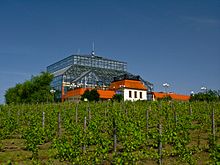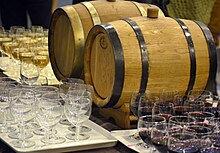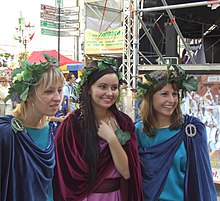Viticulture in Poland









The viticulture in Poland is in almost all provinces instead. Most of the vineyards , however, are located in the south of the country, where there was a tradition of viticulture for centuries until the beginning of the Little Ice Age , which made viticulture in Poland unprofitable for a long time.
history
middle Ages
Archaeobotanical finds show viticulture in the region of Krakow on the Wawel as early as around the year 1000. With the Christianization and the beginning of the monastery culture, the importance of viticulture in Poland grew. Viticulture probably came to Lesser Poland from the Great Moravian Empire . Western European wine culture came to Poland with the adoption of Latin Christianity in the middle of the 10th century. The first known documentary mention of viticulture in Poland is in the Papal Bull of Gniezno , which dates from 1136 and mentions vineyards in the Płock and Włocławek area on the Lower Vistula . Benedictines and Cistercians planted vineyards for liturgical purposes in their monasteries. For example, the Cistercians planted vines in the Paradies monastery around 1250. Wine culture got a further impulse with Heinrich IX. von Glogau , who introduced and cultivated new grape varieties from Hungary , Tyrol and Franconia . These were Traminer , Silvaner and Blauer Spätburgunder , probably also Riesling . In contrast to the development of the art of brewing beer, the medieval urban bourgeoisie was initially hardly involved in the development of viticulture in Poland. This changed in the 14th century, when several towns specialized in viticulture, whose names still bear witness to this tradition: Winna Góra , Winogrady , Winiary , Winnica . The most important growing areas were Lower Silesia around Grünberg and Lebus , Greater Poland around Posen , Thorn , Płock, Sandomir and Krakau on the Vistula, and Krossen and Przemyśl in the Subcarpathian region .
Early modern age
The Medieval Warm Age ended at the beginning of the Early Modern Age and the Little Ice Age began in the 15th century and lasted into the Industrial Age. This made viticulture difficult in Poland, which was becoming increasingly uneconomical. In addition, there was an expansion of the infrastructure in Poland, which made importing wines cheaper. With increasing economic exchange in the 16th century, viticulture declined because it could be imported inexpensively from climatically favorable regions. Hungary developed into the main supplier, as well as France, Italy and Germany with significantly lower market shares were popular import regions. The Tokaj has been the favorite wine of Poles for centuries. The Szlachta bought or leased entire vineyards in Hungary in order to then import large quantities of the wine to Poland via the Carpathian trade routes . In Poland-Lithuania , however, only small amounts of wine were produced, mostly for personal use. The producers switched to drinking honey , a Polish specialty of honey wine , and vodka . Around 1800 the vineyard area in what is now Poland was planted on 1700 hectares and was essentially limited to Silesia (then a Prussian province).
Modern
The first sparkling wine to be produced in Germany using the champagne method was produced from 1826 by Häusler, Förster & Grempler with Grünberger sparkling wine in the vicinity of Grünberg / Lower Silesia (today's wine-growing region of Zielona Góra ) and in 1938 it achieved an annual production of 800,000 bottles. From 1880, Fritz Brieger, a second sparkling wine producer, was added. There was also cognac production: the Albert Buchholz company was considered the largest in Germany at the time. The region around Grünberg was the northernmost wine-growing region in Europe at that time. Wilhelm von Hamm, however, wrote in Der Weinbau in Schlesien, Posen and Brandenburg in the second half of the 19th century : “In Germany there is hardly a wine better known than the Grüneberger; His name has passed into popular parlance to designate a right throat cleaner, and anyone who hears of him as a real wine drinker shakes. ”After the Second World War and the expulsion of the German population , the cultivation from Silesia disappeared. In the People's Republic of Poland , no value was placed on the revitalization of viticulture.
present
Although the vineyard area of 500 ha (2011) and a wine production of around 200,000 hl (2004) is still very small, it is growing steadily. In 2005 Poland was recognized as a wine country by the EU . The most popular vines grown are: Riesling , Chardonnay , Gewürztraminer , Pinot gris , Sylvaner , Seyval Blanc , Bianca , Musca , Regent and Rondo .
In 2017 there were 433 vineyards in Poland. The largest vineyards in Poland include the vineyard in Zabór with 35 hectares and the vineyard Srebrna Góra in Kraków with 28 hectares, while the smallest vineyards have barely 0.01 hectares. The oldest currently operated vineyard is Magdalenka in Andrychów at the foot of the Little Beskids , which has been producing wine since 1980. New vineyards are constantly emerging. The lowest vineyard is in Darłowo on the Baltic Sea at 6 meters above sea level and the highest in Zubrzyca Górna on the slopes of the Saybuscher Beskids in Podhale at 770 meters above sea level. The northernmost vineyard is in Słupsk in Pomerania and the southernmost in Łapsze Niżne on the slopes of the Pieninen in the Polish Spiš . The most important centers of viticulture in Poland are now again the Beskydy Mountains and the Subcarpathian region in the Lesser Poland and Subcarpathian Voivodeships .
Regions
After the Second World War, the authorities distinguished two wine-growing regions: West (region around Zielona Góra and Lower Silesia ) and Central (along the Pilica ). Currently, a distinction is made between the following cultivation areas based on climatic conditions:
- Region I - West and Southwest,
- Region II - South and Southeast,
- Region III - North and Central Poland.
Region I.
In the rural open-air museum of Zielona Góra , information is also provided about viticulture in the region. There is also a reconstruction of a typical winegrower's house.
In 1990 Zielona Góra had two hectares of vineyards, ten years later five hectares, and at the end of 2016 100 hectares. In 2002 the government created a national wine law, which was finally passed in 2008. This stipulates the obligation, similar to the Chianti region, to provide each bottle with a tax label in order to guarantee proper handling and origin. Without this banderole - which is only handed out if certain quality regulations are complied with - the wine is not allowed to be sold. After the enactment and ratification of the national wine law, Poland was officially recognized by the European Union as a wine-growing country with Regulation (EC) No. 479/2008.
With two successful winemakers of the fifth and sixth generation, descendants come from the wine region around Zielona Góra: Peter Lehmann and Johann Christian Henschke , both of whom are located in the Barossa Valley .
Even if the traditional region around Zielona Góra is no longer the most important and largest, investments are made there in the future. In 2012, in addition to 100 ha of crop cultivation, 35 ha were under new cultivation. A wine cooperative was also established there. The Krakow , Rzeszów and Wroclaw wine regions are now larger than Zielona Góra.
Today mainly hybrid varieties and new breeds with very large diversification are cultivated, because many hobby winemakers cultivate them in very small parts.
climate
The climate in Poland is characterized by strong temperature fluctuations during the day and year. Frost and hail pose a risk in winter, but also in spring. Because of the cool climate, the grapes have a low sugar and higher acid content compared to those from southern Europe. Nevertheless, there are regions in Poland that have climatic characteristics that are comparable to Champagne .
Festivals
There are two major wine festivals in Poland:
Web links
- Map of vineyards in Poland
- Zielonogórskie winnice , viticulture in Zielona Góra February 11, 2008
- Polish Institute of Grapevines and Wine
- Winicjatywa
- Polish wines
See also
Individual evidence
- ↑ Małgorzata Pink, Joanna Ligenzowska: The problems of winemaking in Poland. University of Agriculture in Cracow, accessed January 4, 2017 .
- ↑ Wojciech Bosak: Uprawa winorośli i winiarstwo w małym gospodarstwie na Podkarpaciu. Poradnik dla początkujących. Jasło: 2004
- ↑ Roman Myśliwiec: Uprawa winorośli. Wydawnictwo Plantpress, Kraków 2009, p. 9.
- ↑ a b Heidi Diehl: Courage and passion make Bacchus's eyes shine again. ( Memento of the original from January 5, 2017 in the Internet Archive ) Info: The archive link was inserted automatically and has not yet been checked. Please check the original and archive link according to the instructions and then remove this notice. YOOPRESS Wine Media Portal, Würzburg, section Wine and Wine Culture , January 3, 2017
- ↑ Heidi Diehl: Wine from Poland? But of course! , New Germany September 4, 2010
- ↑ a b c d Peter Moser: Wine instead of vodka , Falstaff , 02/2012, pp. 42–45
- ↑ a b Cora Stephan: Silesian wine . June 24, 2013
- ↑ Werner Ribbeck: Grünberg in Silesia, the northernmost wine-growing town on earth: then and now. Berlin / Leipzig / Vienna 1929, p. III.
- ↑ Mirosław Kuleba: Ampelografia Zielonej Góry. Zielona Góra: Pro Libris, 2005, ISBN 978-83-88336-49-2 (Polish)
- ^ Ewa Wawro: Vineyards in Poland. Warsaw: MULTICO Verlag, 2011. ISBN 978-83-7763-043-3 , p. 16 (Polish)
- ^ Nancy Waldmann: Zielona Góras winemakers will soon be able to serve their own grape juice , Lausitzer Rundschau , September 13, 2008
- ↑ Alina Kunicka-Styczynska, Agata Czyzowska, Katarzyna Rajkowska, Agnieszka Wilkowska, Piotr Dziugan: The Trends and Prospects of Winemaking in Poland . InTech, 2016, doi : 10.5772 / 64976 ( intechopen.com ).
- ↑ Council Regulation (EC) No. 479/2008 (PDF), accessed on January 4, 2017
- ^ Hugh Johnson, Steven Brook: The great Johnson : The encyclopedia of wines, wine-growing regions and wine producers of the world , Verlag Gräfe und Unzer, 2012 ISBN 3-8338-3158-8 , pp. 567-568

